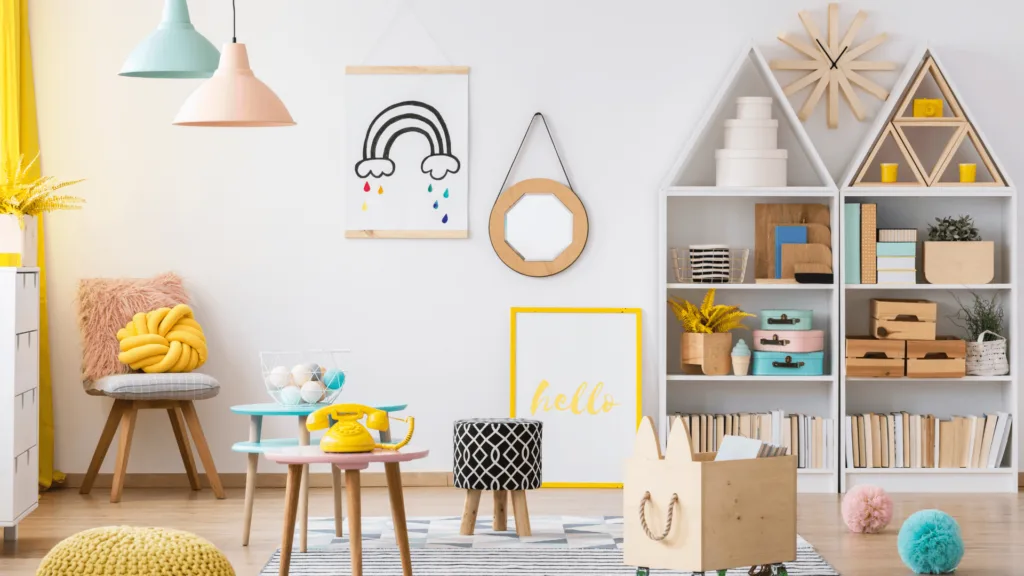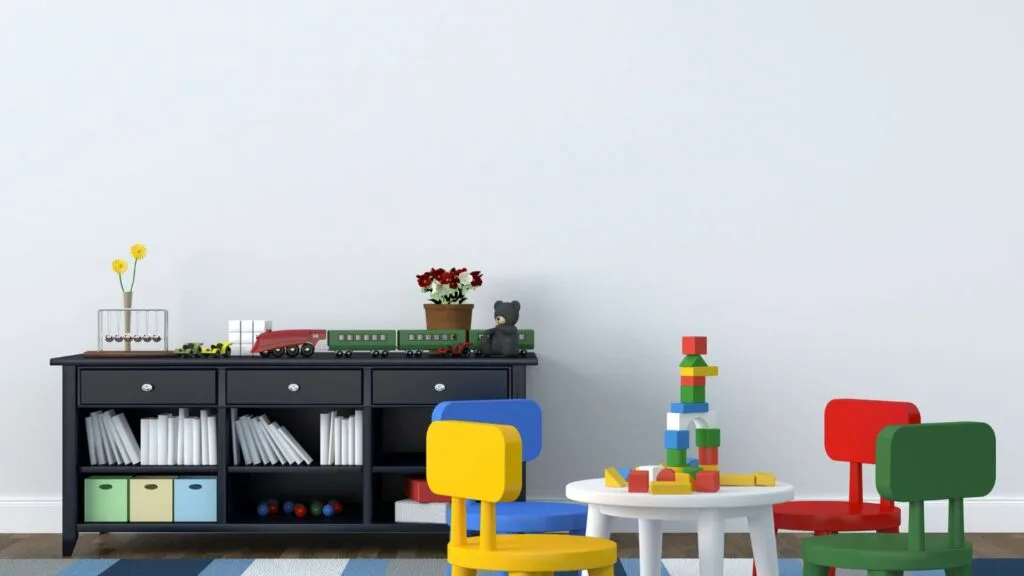Creating the ideal playroom for your little one can be a fun and rewarding project that will provide your child with a safe, stimulating, and organized space to play and learn. A well-designed playroom can promote creativity, encourage physical activity, and provide a nurturing environment for your child to grow and develop.
This article will advise you on how to create the ideal playroom for your little one, by providing you with a few essential elements to consider when designing the area.

Safety First
The most important consideration when creating a playroom for your child is safety. The playroom should be free from any hazards such as sharp corners, choking hazards, and heavy furniture that could topple over. It’s essential to childproof the room by installing safety gates, securing furniture to the wall, and covering electrical outlets. Additionally, it’s crucial to choose non-toxic, child-friendly materials for flooring and furniture to ensure that the playroom is a safe and healthy environment for your child to play in.
Stimulating and Educational Toys
An ideal playroom should be stocked with a variety of toys that promote learning, creativity, and physical activity. Choose toys that encourage open-ended play, such as building blocks, art supplies, and pretend play props. You should also be mindful that not all toys may be safe for your little one, and it is recommended you read a safe, non-toxic toy guide so that you learn more about this subject and ensure that you incorporate age-appropriate books and puzzles that can also help foster a love for reading and problem-solving skills. Consider rotating toys regularly to keep the playroom fresh and exciting for your child.
Ample Storage
A well-organized playroom is essential for maintaining a tidy and functional space for your child to play in. Incorporating ample storage solutions such as shelves, bins, and toy chests can help keep toys and supplies organized and easily accessible. Including labeled bins and shelves can also encourage your child to take responsibility for cleaning up after playtime. Utilizing storage solutions that are within your child’s reach can empower them to take an active role in keeping the playroom neat and organized.
Comfortable and Cozy Space
Creating a comfortable and cozy area within the playroom can provide your child with a relaxing space to read, play, or unwind. Consider adding soft area rugs, floor cushions, and bean bags for your child to lounge on. Including a designated reading nook with a plush chair and a bookshelf can encourage quiet activities and relaxation. Additionally, incorporating sensory elements such as stuffed animals, soft textures, and calming colors can help create a soothing environment for your child to enjoy and relax in.
Playful and Engaging Decor
The decor of the playroom should be bright, colorful, and engaging to stimulate your child’s imagination and creativity. Consider incorporating wall decals, murals, or artwork that reflects your child’s interests and passions. Hanging a chalkboard or whiteboard on the wall can provide a space for your child to express their creativity and engage in imaginative play. Adding a play tent, indoor swing, or climbing wall can also provide opportunities for active play and exploration within the playroom.
Personalization
Personalize the playroom with your child’s favorite colors, themes, and interests. Let them add their artistic touch by displaying their artwork, crafts, and projects on the walls. This will make the playroom feel like their own special space and foster a sense of pride and ownership. You can explore various kids playroom ideas to incorporate personal touches that reflect your child’s interests and quirks, whether it’s through themed decor, unique storage solutions, or custom zones that allow them to express their creativity.
Multi-functional Design
Consider a multi-functional design that allows the playroom to adapt to different activities and age groups. For example, a table with adjustable height can be used for arts and crafts, as well as for playing games or having snacks. Choose furniture that can be easily moved and rearranged to accommodate different play scenarios.
Parental Involvement
Incorporating spaces for parents to interact and engage with their children in the playroom is essential for fostering a strong bond and creating lasting memories. Consider including comfortable seating for parents to observe and play with their children. Setting up a small table and chairs for creative activities like arts and crafts or puzzles can provide opportunities for quality bonding time. Additionally, incorporating open shelving to display your child’s artwork and achievements can create a sense of pride and accomplishment for both you and your child.

Creating the ideal playroom for your little one involves careful consideration of all the factors discussed on this page. By incorporating these essential elements, you can create a nurturing and stimulating environment for your child to play, learn, and grow. A well-designed playroom can provide countless hours of fun and creativity for your child while also offering peace of mind for parents knowing that their little one is safe and happy in their own little corner of the world.

Jessi is the creative mind behind The Coffee Mom, a popular blog that combines parenting advice, travel tips, and a love for all things Disney. As a trusted Disney influencer and passionate storyteller, Jessi’s authentic insights and relatable content resonate with readers worldwide.
